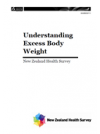Obesity is New Zealand’s leading modifiable risk factor for health loss. A number of diseases, including type 2 diabetes, ischaemic heart disease, ischaemic stroke and some cancers, are associated with excess body weight. Health loss can lead to premature death; life expectancy for the extremely obese is shortened by 8 to10 years.
There has been a dramatic increase in the global prevalence of obesity. In 2012 New Zealand adults ranked third highest out of 15 OECD countries for measures of obesity; in 2010 New Zealand children (aged 5–17 years) ranked third highest out of 40 countries for overweight (including obesity).
This publication explores the increase in obesity over a 36 year period to 2013 and investigates the impact of obesity on different birth cohorts. It reviews the current status of adult and child obesity in New Zealand, looking at the population groups that are affected most.
The report also looks at the prevalence of extreme obesity, where health impacts on individuals are likely to be most pronounced.
Key Results
This analysis highlights the scale of the obesity epidemic in New Zealand: 30 percent of adults and 11 percent of children were obese in 2011-13. In addition, a further 35 percent of adults and 21 percent of children were overweight. Over 2.5 million New Zealanders – more than half the population – were either overweight or obese.
Since the late 1970s, the adult obesity rate has increased three-fold; from 10% in 1977 to 30% in 2011–13. The increase in adult obesity is evident across all age groups, with an average 3 percent increase in the obesity rate per year.
There is a lack of data on historic obesity trends for children; however, the childhood obesity rate increased from 9 percent in 2006/07 to 11 percent in 2011–13. The latest data from the 2013/14 New Zealand Health Survey (Ministry of Health 2014) indicates that the childhood obesity rate may be stabilising with 10% of children obese. If the rate is stabilising, it would bring New Zealand in line with a number of other OECD countries which have seen their childhood obesity rates stabilise (and, in the case of Mexico and England, slightly decline) over the same time period (OECD 2014).
The increase in obesity among younger adults means that these individuals will spend a much greater proportion of their lifetime obese, making them more susceptible to obesity-related ill health. There is already an increased prevalence of type 2 diabetes mellitus in children and youth in New Zealand (Hotu et al 2004; Jefferies et al 2012).
The age at which the obesity rate peaks is also increasing, which may be due to improved survival among obese adults. A more obese elderly population is likely to result in increased rates of chronic disease and an increased number of individuals living with multiple health conditions.
This report highlights the prevalence of extreme obesity in New Zealand: 4 percent of adults have a BMI of ≥ 40 kg/m2 and 5 percent of children have a BMI of ≥ 35 kg/m2. This means 147,000 adults and 35,000 children are at very high risk of obesity-related health problems, and are accordingly likely to represent a significant burden to the health sector.
Extreme obesity is a particular concern among Pacific peoples and Māori. Rates of extreme obesity are five times higher in Pacific adults and nearly four times higher in Pacific children than they are in the non-Pacific population. Among Māori, extreme obesity rates are nearly three times as high in adults and more than twice as high in children as they are in non-Māori.
Previous New Zealand Health Survey publications have already highlighted the socioeconomic disparities in obesity rates. After adjusting for age, sex and ethnic differences, obesity rates among those living in the most deprived areas are almost twice as high for adults and 2½ times as high for children, compared with those living in the least deprived areas. Analyses in this report show that these disparities are even greater for extreme obesity. Both adults and children living in the most deprived areas are four times as likely to be extremely obese compared with those living in the least deprived areas.
The analysis of parental perception of child weight in this report highlights that the majority of parents are unaware that their obese child is overweight. This is particularly the case among those living in the most deprived areas and parents of young children. Perhaps because of the general increase in childhood obesity, our perception of what normal, healthy weight looks like in a child may have changed. These findings will be of interest to those looking to promote the development of healthy habits in children.
The aim of this report was to provide an overview of the epidemiology of obesity. In doing so, the researchers have identified a number of areas for future analysis. The birth cohort analysis presented in this report highlights the historic growth in obesity; the obvious question is what the future holds. This report does not provide obesity projections, which would require more detailed analysis of factors influencing obesity rates in the future, including immigration, changes in life expectancy and the impact of current policies.
Further research linking the alternative measures of excess body weight presented in this report with particular health outcomes would help identify the most appropriate measures to assess disease risk among different population groups. Linking data from the New Zealand Health Survey with hospitalisation data would also enable a more detailed understanding of the health risks and health care usage associated with obesity and extreme obesity.
New Zealand Health Survey data is available to researchers through Statistics New Zealand datasets. The Ministry of Health encourages other researchers to explore this rich data source.

